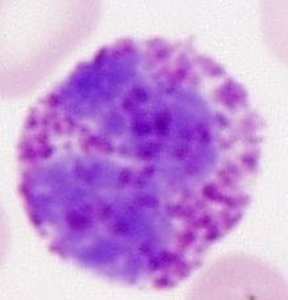

MedFriendly®


Basophilic
Basophilic is an adjective that is used to describe parts
of cells that stain well when exposed to dyes (a type of
coloring). The term is used by histologists, who are
scientists who study the structure of cells and tissues
of plants and animals under the microscope. The cells
are sometimes stained with various chemical dyes. The
dyes can then react with certain features of the cells. If
the features are present, the cell will show up a certain
color (usually deep blue) such as purple. An example of
a cell that stains well when exposed to dyes is a
basophil, which is pictured to the right.
A basophil under the microscope.
FEATURED BOOK: Mosby's Diagnostic and Laboratory Test Reference
The most commonly used dyes by histologists are known as hemalum and eosin Y, which
is why the technique is known as the HE stain or the H&E stain.
Cells that absorb dyes usually contain nucleic acid. Nucleic acids are substances found
in all living things that play a major role in the continuation of life.
Basophilic comes from the Greek word "basis" meaning "foundation," the Greek word
"philein" meaning "to love," and the Greek word "ikos" meaning "pertaining to." Put the two
words together and you have "pertaining to love foundation."
"Where Medical Information is Easy to Understand"™















